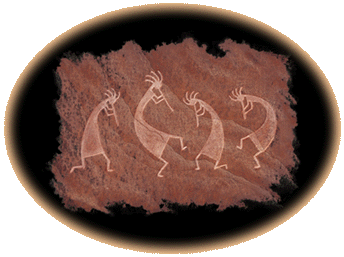

Ko-ko-pel-li (kô kô pel´ lê) n. {der. Hopi "kokopilau" (koko = wood, pilau = hump)} the humpbacked Flute Player, mythical Hopi symbol of fertility, replenishment, music, dance, and mischief.
The mysterious Kokopelli character is found in a number of Native American cultures, being especially prominent in the Anazasi culture of the "Four Corners" area. The figure represents a mischievous trickster or the Minstrel, spirit of music. Kokopelli is distinguished by his dancing pose, a hunchback and flute. His whimsical nature, charitable deeds, and vital spirit give him a prominent position in Native American mysticism.
Kokopelli has been a sacred figure to Native Americans of the Southwestern United States for thousands of years. Found painted and carved on rock walls and boulders throughout this region, Kokopelli is one of the most intriguing and widespread images to have survived from ancient Anasazi Indian mythology, and is a prominent figure in Hopi and Zuni legends. Kokopelli is also revered by current-day descendants including the Hopi, Taos and Acoma pueblo peoples.
Kokopelli is considered a symbol of fertility who brought well-being to the people, assuring success in hunting, planting and growing crops, and human conception. His "hump" was often considered a bag of gifts, a sack carrying the seeds of plants and flowers he would scatter every spring. Warming the earth by playing his flute and singing songs, Kokopelli would melt the winter snow and create rain, ensuring a good harvest. Kokopelli often displayed a long phallus, symbolizing the fertile seeds of human reproduction.

"He of the singing reed,
He of the sacred seed,
comes to assure the fertility
and good fortune of our people."
-- Linda Lay Shuler
| ||||||